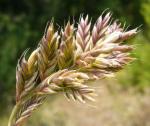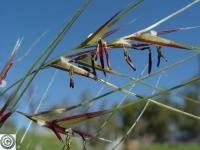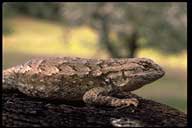Grasslands
Grassland is a relatively common landcover within Napa County, covering over 53,700 acres or nearly 11% of the county. Grassland species composition is highly diverse and provide habitat for a number of reptiles, mammals, and birds. Large grassland areas are most common in the southeastern portion of the County, around the cities of American Canyon and the valley floor of Napa.
Three types of grassland assemblages exist within Napa County:
- Annual grassland
- Native grassland
- Serpentine (bunchgrass) grassland
Annual grassland is an herbaceous plant community usually dominated by non-native annual grasses such as wild oat (Avena), brome (Bromus) grasses, and wild barley (Hordeum) species.

Brome - Bromus - Non-Native

Barbed Goatgrass - Aegilops triuncialis - Non-native
(Commonly known and infamous for plaguing dogs by burrowing into their paws or noses.)

Medusa Head - Taeniantherum caput-medusae - Non-native
Native grassland is dominated by a mixture of annual and perennial grasses such as small fescue (Vulpia microstachys), purples needlegrass (Nasella pulchra), nodding needlegrass (Nasella cernua), and Small-flower Melicgrass (Melica imperfecta).

California fescue - Festuca californica - Native to California

Small-flower Melicgrass - Melica imperfecta - Native to California

Purple needlegrass - Stipa pulchra - Native to California
Serpentine (bunchgrass) grassland occurs on soils derived from serpentine and generally has less overall vegetation cover. Bunchgrasses typically occur in patches and are primarily dominated by medusa head, goatgrass (Aegilops triuncialis) and foxtail brome (Bromus madritensis). However many different flowers also grow in our Serpentine Grasslands
Two carpellate western flax, Twocarpel dwarf flax - Hesperolinon bicarpellatum - Native and endemic to California
Fairy Fan or Brewer's clarkia - Clarkia breweri - Native and endemic to California
Clara Hunt's milk vetch - Astragalus claranus - Native and Threatened in California
Silky balsamroot - Balsamorhiza sericea - Native and Threatened in California
The western fence lizard (Sceloporus occidentalis), common garter snake (Thamnophis sirtalis), and gopher snake (Pituophis catenifer) are a few examples of the variety of reptiles found in grassland. Mammals typically found in grassland habitats include the black-tailed jackrabbit (Lepus californicus), California ground squirrel (Spermophilus beecheyi), western harvest mouse (Reithrodontomys megalotis), and coyote (Canis latrans). Grassland provide breeding habitats for birds including the western kingbird (Tyrannus verticalis), loggerhead shrike (Lanis ludovicianus), California horned lark (Eremophila alpestris actia) and the western bluebird (Sialia mexicana).
Reptiles and Amphibians

Western fence lizard
Sceloporus occidentalis

Garter snake
Thomnophis sirtalis

Gopher snake
Pituophis catenfornifer
Birds

California horned lark
Eremophila alpestris actia

Loggerhead shrike
Lanius ludovicianus

Western kingbird
Tyrannus verticalis
Mammals

California ground squirrel
Spermophilus beecheyi

Black-tailed jackrabbit
Lepus californicus

Coyote
Canis latrans
The primary ecosystem functions of grassland in the County are:
- Maintain water quality through soil retention and by filtering out sediment and nutrients from run-off
- Prevent flooding and minimize channel erosion by slowing surface runoff
- Increase infiltration to groundwater
- Provide habitat
- Provide fodder for grazing livestock
- Provide opportunities for recreation, including but not limited to hunting, bird-watching, hiking, horseback riding, and OHV use
These functions are enhanced when the key characteristics of grassland habitats are comprised of high-cover herbaceous vegetation, a low-cover of woody vegetation, and low to moderate levels of disturbance.
Use the map below to explore the various biotic communities throughout Napa County.





